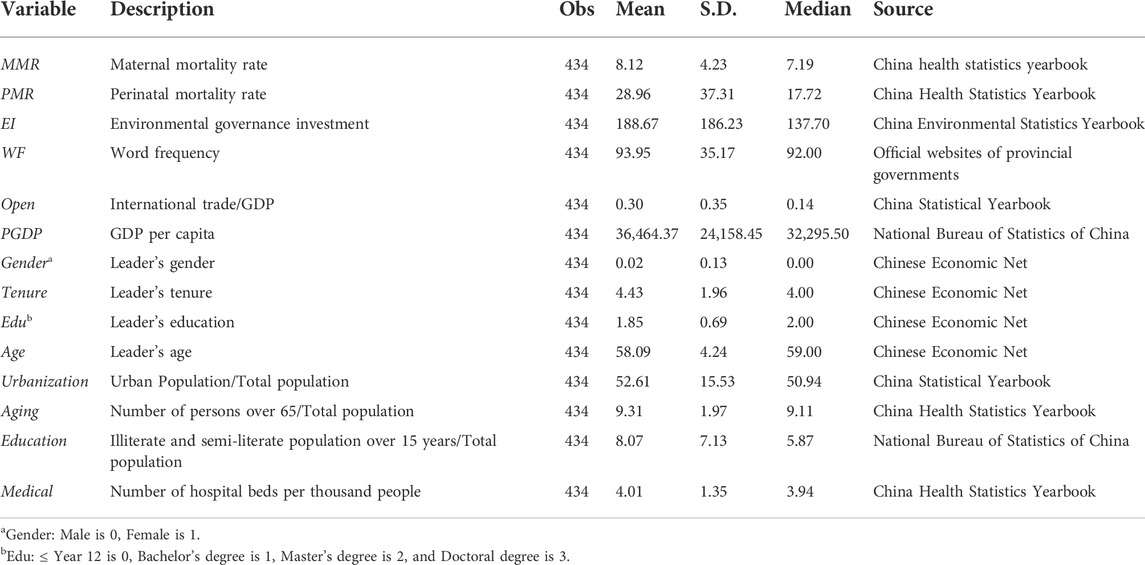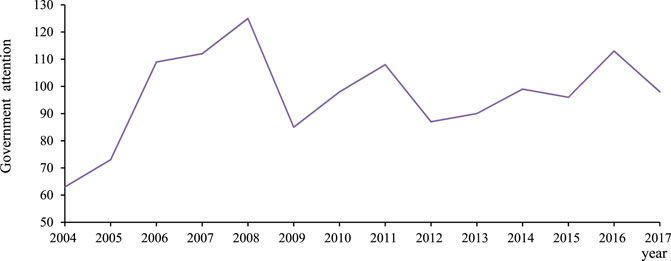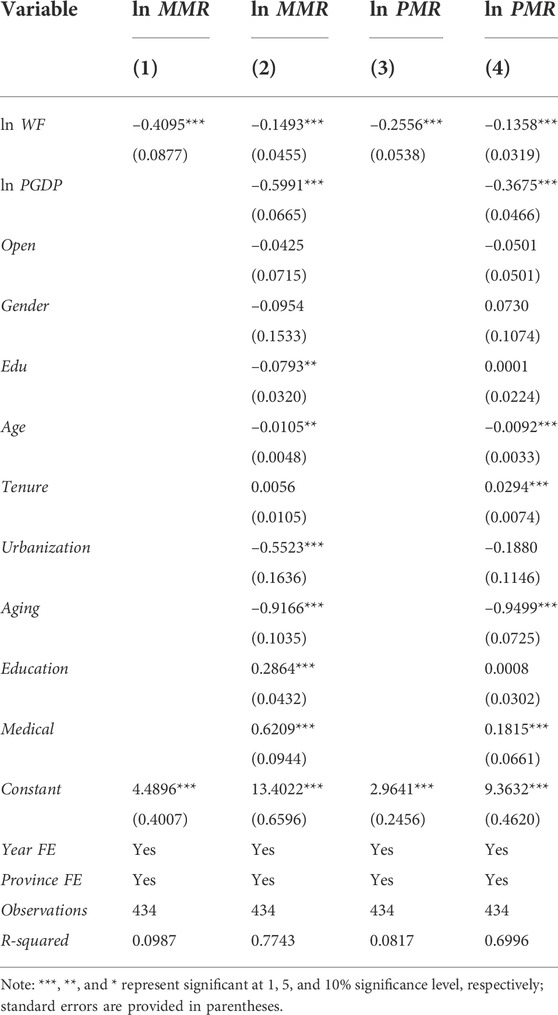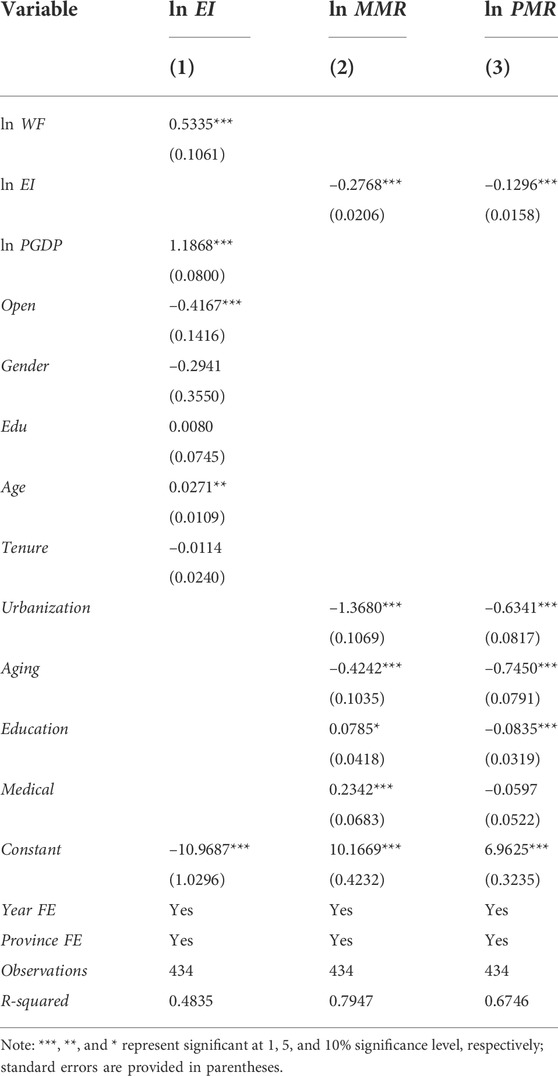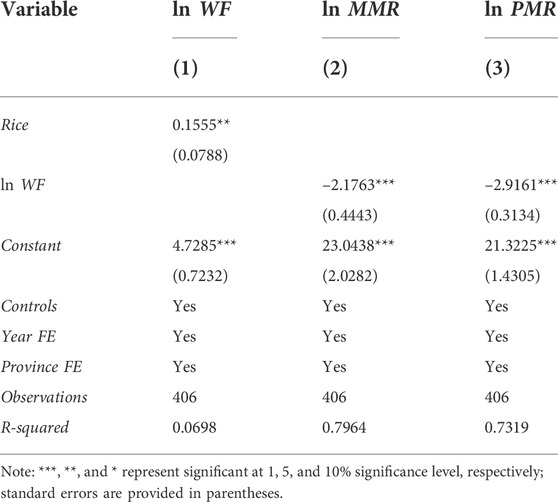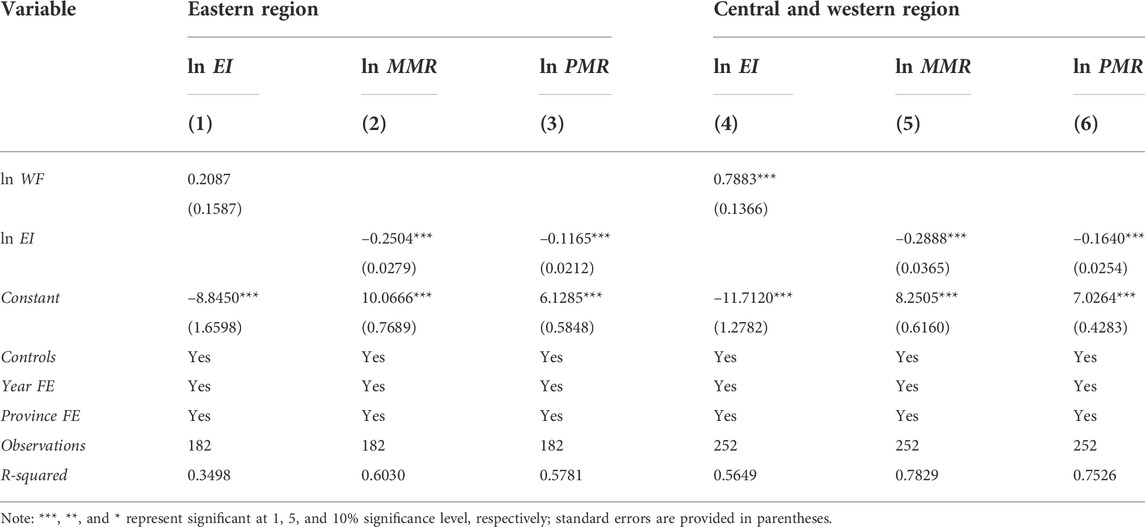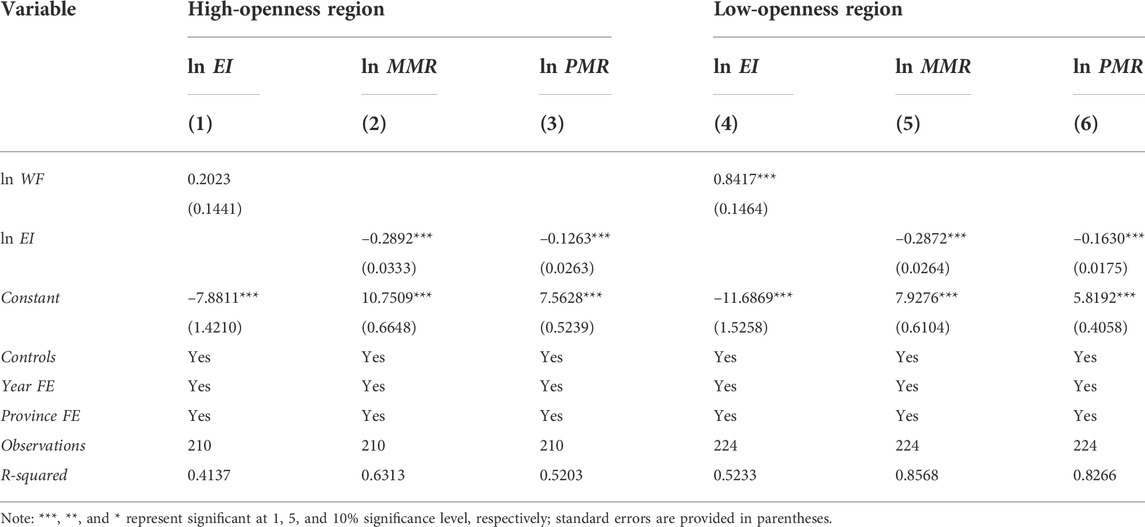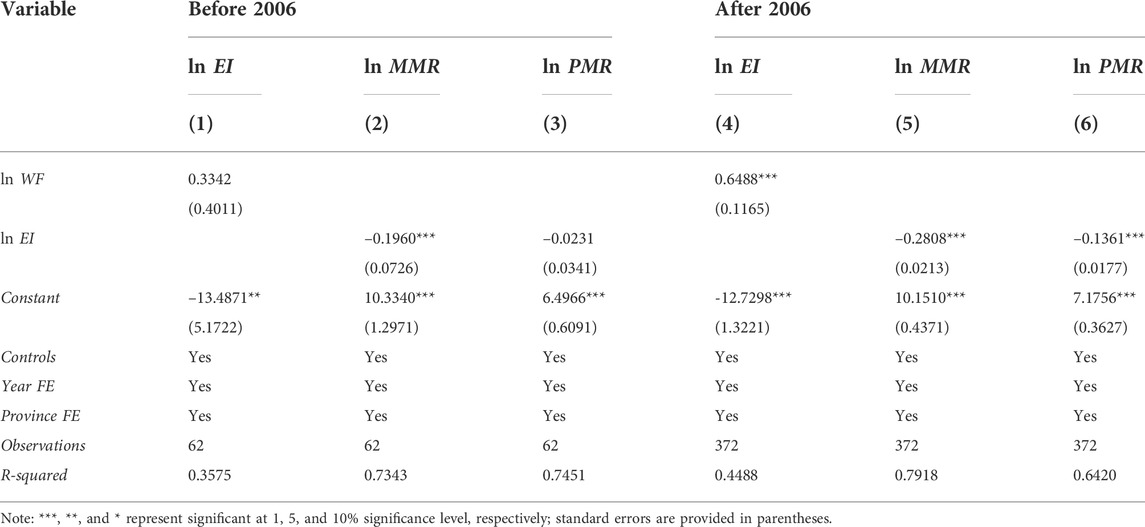The impact of government environmental attention on public health: Implications for corporate sustainable development
- 1School of Statistics and Mathematics, Shandong University of Finance and Economics, Jinan, China
- 2Research Center for Statistics and Interdisciplinary Sciences, Shandong University of Finance and Economics, Jinan, China
- 3School of Business Administration, Shandong University of Finance and Economics, Jinan, China
As major contributors to air pollution, enterprises have a growing impact on the environment, which puts public health at risk and requires urgent government intervention. This study constructs a government environmental attention variable via textual analysis of Chinese government work reports from 2004 to 2017, and examines the impact of government environmental attention on public health. We find that local government environmental attention has a significant and positive impact on public health. Our mechanism analysis suggests that government environmental governance investment acts as an important mediating channel in transferring the impact of government environmental attention on public health. Moreover, we find that the impact of government environmental attention on public health is more pronounced in Central and Western China, in low-openness regions, and after the incorporation of environmental performance in the cadre evaluation system in 2006. Overall, our study links micro-level environmental issues with macro-level governmental behaviors, providing a new perspective for future research on the influencing factors of public health and practical implications for corporate sustainable development.
1 Introduction
Environmental pollution has become a major threat to human survival (Schwarzenbach et al., 2010; van Heezik and Brymer, 2018; Pérez Ibarra et al., 2020). According to the National Bureau of Statistics of China, China’s sulfur dioxide, nitrogen oxides, and particulate matter emissions in 2020 reached 3.182 million tons, 11.817 million tons and 6.134 million tons, respectively, with a proportion of 86.46%, 44.42% and 85.07% from the industrial production. As the primary pollutant emitters and resource consumers, businesses have an inescapable responsibility to address environmental problems. Studies show that the deteriorated environment has shortened the average global life expectancy (Ebenstein et al., 2015), posing a severe threat to public mental and physical health (Cesaroni et al., 2012; Lelieveld et al., 2015; Cohen et al., 2017). Therefore, firms, as the building blocks of economic growth, should establish an environmental governance accountability mechanism and actively engage in the green transformation to alleviate environmental and public health problems.
However, firms are not carrying out their fair share of social responsibility due to free-riding behaviors and conflict between economic and social costs. Environmental governance ought not to rely solely on voluntary actions by businesses and individuals; the government should play an active role (Duan et al., 2020; Bansal et al., 2021; Tian et al., 2020). Specifically, governments can improve environmental governance performance through the implementation of environmental protection policies and regulations (Magnani, 2000; Biresselioglu and Demir, 2021; Kang et al., 2022), environmental governance investments (Ercolano and Romano, 2018), and regional joint prevention and control mechanisms (Yang, 2016). Since 2002, the Chinese government has promulgated a number of environmental regulations and policies to balance economic development with environmental costs (Li et al., 2021; Wan et al., 2021; Zhai et al., 2022), leading to dramatic improvement in the country’s environmental quality. In 2019, the average percentage of days with good air quality in China’s 337 cities reached 82%. China’s environmental regulation and governance are becoming increasingly stringent in recent years (Xue et al., 2021; Liu et al., 2022). For example, the central government added local environmental performance into the cadre evaluation system in 2006, creating incentives for local officials to raise their environmental awareness and improve environmental governance practices (Yang et al., 2020). Also, during the ongoing COVID-19 pandemic, China made a commitment to reach a carbon peak by 2030 and carbon neutrality by 2060 (Tian et al., 2022).
The annual government work report—a policy document that reviews local government performance over the previous year and outlines future work plans—reflects the allocation of government attention (Wen, 2014). Attention refers to the psychological activity in which the subject consciously focuses on a certain thing (Ocasio, 2011).
Jones (1994) introduced the concept of attention into the research area of government behavior and proposed an attention-driven model of policy choice. This psychological model provides a new study angle on governmental behavior by arguing that the priority of government policy shifts in response to the changes in government attention. Because government is the principal executive of national governance and social administration, the allocation of government attention reflects the priority in public affairs (Boydstun et al., 2014). With limited attention, the choice of government behavior depends on matters attracting the most attention (Ocasio, 2011). Thus, the allocation of government attention in specific social areas requires further study.
Prior research has used government work reports to measure government attention. For example, Wen (2014) employed textual analysis of government work reports to measure government attention to public services. Similarly, Wu and Tang (2019) employed textual analysis of central government work report from 1978 to 2018 to measure the proportion of central government attention to the ageing problem. However, neither of them addressed the question of whether government attention is translated into practice. Among the few existing studies, Shi et al. (2019) examined the impact of provincial government work reports on substantive environmental investments by analyzing their discourse on environmental protection. But the impact of government attention on people’s well-being is still scarce (Diener and Seligman, 2004).
In summary, we find that, first, most government attention-related studies focus on attention measurement, and few investigated whether government attention is translated into practice. Second, research on the impact of government attitudes and behaviors on public health is lacking. Finally, the mechanism through which governmental environmental attention affects public health should be explored. Therefore, the study on whether and how government environmental attention affects public health is vital to the public health research and environment psychology (Navarro et al., 2020).
In this paper, we choose China as the research setting to examine the relationship between government environmental attention and public health for two reasons. First, in recent years, the conflict between the ecological environment and economic development has grown more pronounced in China in recent years, and it is crucial to address the worsening environmental pollution and improve people’s well-being in order to meet both the demand of people for a better life and the shift in the mode of economic development. Second, because the Chinese government plays a predominant role in the economy and performs a range of functions, such as decision-maker, supervisor, and governor, government attention and actions play an important role in public issues like improving environmental quality (Jiang et al., 2021; Wang et al., 2021). Therefore, using text mining to construct the government environmental attention variable, we select local government work reports from 31 provinces in Mainland China from 2004 to 2017 as the research object to empirically examine the relationship between government environmental attention and public health. The results show that government environmental attention significantly and positively affects public health. In addition, our mechanism analysis indicates that government environmental attention can improve public health through increased environmental governance investment. These findings remain robust after replacing explanatory variables and mitigating endogeneity concerns. Additional analyses reveal that the impact of government environmental attention on environmental governance investment is significantly positive in Central and Western China, in low-openness regions, and after the inclusion of environmental performance in the cadre evaluation system in 2006. As such, our study extends the government attention-driven policy choice model to environmental psychology research, which provides an empirical basis for translating government attention into practice and important implications for guiding firms to assume social responsibility and adhere to sustainable development.
The remainder of this paper is structured as follows. Section 2 introduces the data source and research methodology. Section 3 presents and interprets the empirical results. Section 4 concludes the paper and proposes policy recommendations.
2 Materials and methods
2.1 Model setting
China has had rapid economic growth since the reform and opening up, but the environment has suffered tremendous damage. Environmental problems caused by large-scale industrial development, such as the loss of arable land, water pollution, and air pollution, are impeding China’s sustainable development and posing a direct threat to public health (Lu et al., 2019; Tao et al., 2022). According to the report of the Second United Nations Environment Assembly (2018), environmental pollution is responsible for nearly a quarter of all deaths globally. Studies also show that continuous exposure to air pollution reduces life expectancy (Ebenstein et al., 2017). The Chinese government has made many efforts in response to the worsening environmental problems. To strengthen environmental governance, the central government incorporated local environmental performance into the cadre evaluation system in 2006. Given the government’ critical role in environmental governance as well as public health, the primary goal of our paper is to investigate the impact of government environmental attention on public health.
This study examines whether government environmental attention affects public health using government work reports from different provinces in China, and further investigates whether government environmental attention has been translated into environmental governance investment, and if so, whether government investment in environmental governance has an impact on public health. To test the research questions, this paper develops three econometric models. In the baseline regression, we construct a government environmental attention variable from the frequency of environment-related words in the government work reports as the key explanatory variable to examine the relationship between government environmental attention and public health. For the mediation analysis, we choose environmental governance investment as the mediating variable. We first test the relationship between government environmental attention and environmental governance investment, and then use government environmental governance investment as the key explanatory variable to investigate the impact of government environmental performance on public health based on the aggregate health production function.
2.1.1 Baseline model
Attention research mainly focuses on individual decision-making at a micro-level. However, in recent years, attention studies have begun to be broadly applied in government policymaking (Dai, 2017). The government plays a leading role in managing public affairs, where it allocates public resources based on public feedback (De Marchi et al., 2016). From a psychological perspective, government attention is a scarce resource as the government has to cope with an extensive and complicated collection of public information (Meng and Fan, 2021). As such, the government has to allocate limited attention resources to maximize public interests. Government attention is highly reflected in government work reports. Therefore, this paper uses text mining to quantitatively identify government environmental attention based on China’s provincial government work reports. To investigate the relationship between government environmental attention and public health. Following Liu et al. (2017), we run a regression using the following two-way fixed effects specification:
where i is the province, t is the year. Health is the dependent variable, indicating public health. WF is the frequency of environment-related words in the government work reports of each province each year, which measures local government environmental attention. Z denotes the control variables, including gross domestic production (GDP) per capita (PGDP), value of imports and exports (Open), proportion of urbanization (Urbanization), degree of aging (Aging), level of education (Education), level of medical advancement (Medical). In addition, since governors play a leading role in public policymaking, this paper also controls for the personal characteristics of provincial governors, including gender (Gender), education level (Edu), age (Age), and tenure (Tenure).
2.1.2 Mediation model
In this section, we investigate the mediating role of government environmental governance in the relationship between government environmental attention and public health. In response to the worsening environmental pollution, the Chinese government has been increasing its focus on environmental issues. First, government governance decisions are predicated on the allocation of government attention according to the attention-driven policy choice model proposed by Jones (1994). Therefore, driven by the increasing environmental attention, addressing environmental problems, although challenging, becomes a priority for government governance. Second, enhanced government environmental governance will reduce environmental pollution and improve environmental quality, therefore enhancing public health by reducing mortality from diseases linked to environmental pollution (Kelly and Fussell, 2015; Zhang et al., 2019) as well as psychologically influencing residents’ subjective well-being (Xue et al., 2020; Zhao and Sun, 2020). Therefore, following the methodology for mediation analysis proposed by Preacher and Hayes (2008), we construct the framework of “government environmental attention → environmental governance→ public health.”
First, to investigate the relationship between government environmental attention and environmental governance, we establish the following econometric model proposed by Shi et al. (2019).
where
Second, in 1972, Grossman developed a health production function for the first time, but it has a significant drawback in that it does not take into account macro variables such as environmental factors. Government pro-environmental behavior may exert influences on public mental health and thus physical health (Smyth et al., 2008). Therefore, based on an aggregate-level health production function later revised by Filmer and Pritchett (1999), this paper constructs the following econometric model to explore the impact of government environmental governance investment on public health:
where Health is the dependent variable;
2.2 Data and variables
2.2.1 Data
This paper selects 31 provinces in Mainland China as the research setting, with a time span from 2004 to 2017. Government environmental attention (WF) data are based on government work reports sourced from the official websites of China’s provincial governments.
Besides, we use a web scraping technique to obtain the characteristic variables of provincial governors from the China Economic Net website and then manually cross-validate the data obtained to ensure data reliability. Other regional variable data come from China’s National Bureau of Statistics, Statistical Yearbook, Health Statistics Yearbook, and Environmental Statistics Yearbook.
2.2.2 Measuring government environmental attention
Following Shi et al. (2019), we construct the government environmental attention variable using textual analysis, which is a methodology that incorporates qualitative and quantitative analysis. It was initially utilized in intelligence and informatics but it is now widely used in social sciences as well (Zhang et al., 2021). In this paper, we use the natural language processing (NLP) approach, which is a text mining technique that automatically transforms unstructured texts into structured data and allows researchers to perform quantitative analysis. Through NLP, we can obtain the frequency of environment-related words appearing in government work reports, so as to construct the environmental attention variable. The specifics of the process are as follows.
In step 1, we construct the environmental dictionary. We use Python’s Jieba package to automatically split the words of 465 government work reports yielding 20,000 vocabularies. A prototype environmental dictionary is then created by removing entries that are not related to the environment. To maintain objectivity, we enlist the help of professionals from industry and academia to review and filter the preliminary environmental vocabularies, resulting in the final environmental dictionary, which contains 440 entries that are highly relevant to the government’s environmental attention.
In step 2, we count relevant words according to the environmental dictionary. Based on the built environmental dictionary, we obtain the frequency of environment-related words in the future plan section of the aforementioned 465 government work reports by python. Then we use the obtained word frequency from each government work report to measure government environmental attention.
2.2.3 Variables
The previous section introduced the measurement of the explanatory variable, government environmental attention (WF). Following Shi et al. (2019), we choose environmental governance investment (EI) as a proxy for government environmental governance as the mediating variable, since government environmental governance is primarily reflected through environmental investment expenditures.
We choose pregnant people and perinatal infants as the research setting and use maternal mortality rate (MMR) and perinatal mortality rate (PMR) to measure public health for the dependent variables (McGuire, 2006). This is because pregnant people and infants have a low cross-regional migration rate and research has confirmed that certain pollutants, especially NOX and SO2, are highly associated with an increased risk of perinatal and maternal mortality (Wang et al., 2019). The MMR is the ratio of maternal deaths—those that occur from gestation to 42 days after delivery and are related to pregnancy or pregnancy management causes (excluding accidental deaths)—per 100,000 mothers in a given year. The perinatal mortality rate is the ratio of neonatal deaths—those that occur from 28 weeks of gestation to the 7 days after delivery or with birth weights ≥1,000 g (including fetal deaths and stillbirths)—to the total number of live births.
In addition, we select a set of regional characteristics and governors’ personal characteristics as control variables, which is consistent with existing literature. The regional factors are PGDP (Tamazian et al., 2009), Open (Wang and Chen, 2014; Liu et al., 2017), Urbanization (Liu et al., 2003; Li et al., 2016), Aging (Bolin et al., 2003; Xu and Chen, 2019), Education (Hahn and Truman, 2015) and Medical (Kim and Moody, 1992). The personal characteristics of governors are Gender, Edu, Age, and Tenure (Shi et al., 2019). The variables are detailed in Table 1.
3 Results
3.1 Descriptive statistics
Figure 1 illustrates the changes in the median word frequency of environment-related vocabularies in the government work reports of the 31 provinces from 2004 to 2017. Overall, government environmental attention is showing an upward trend with fluctuations. Between 2004 and 2008, the frequency of environment-related words in the government work report demonstrates a significant growth trend. The rise reflects the incremental transition of government attention from economic growth to environmental protection as a result of severe environmental degradation caused by extensive economic development in the past (Zhang et al., 2020). Such a transition has intensified China’s environmental regulations and governance. During the 5 years from 2004 to 2008, the government promulgated and revised a number of environmental legislations, including the “Solid Waste Environmental Pollution Prevention and Control Law” and the “Renewable Energy Law,” demonstrating a solid commitment for legislative solutions to environmental issues. However, the 2008 global financial crisis (GFC) significantly diverted government attention away from the environment and toward economic recovery. As the impact of GFC began to fade, government environmental attention started to rise steadily again. Notably, government environmental attention peaked at 2011 when the 12th Five-Year Plan started and then at 2016 when the 13th Five-Year Plan started.
3.2 Baseline regression results
Columns (1) and (2) show the impact of government environmental attention on maternal mortality rate (MMR), and Columns (3) and (4) show the impact of government environmental attention on perinatal mortality rate (PMR) Table 2. Specifically, Columns (1) and (3) report the regression results controlling for year fixed effects and province fixed effects without adding any control variables. The results indicate that government environmental attention negatively affects maternal mortality rate (MMR) as well as perinatal mortality rate (PMR) and is statistically significant at the one percent level, suggesting a significant contribution of government environmental attention to public health. In columns (2) and (4), the results indicate that the regression coefficient of government environmental attention (WF) is still significantly negative at the one percent level after controlling for regional characteristics as well as governors’ personal characteristics, further confirming the significant and positive effect of government environmental attention on public health. These findings are consistent with the attention-driven policy choice model, which states that when government environmental attention increases, they make the decision to implement corresponding public policies (Jones, 1994). Therefore, as government environmental attention increases, the government may take actions to address environmental problems, which in turn may affect the level of public health ().
3.3 Mechanism analysis
In this section, we regress Models (2) and (3) to test the mediating effect of government environmental governance investment in government environmental attention and public health. Table 3 presents the regression results. Column (1) shows the impact of government environmental attention on government environmental governance investment, while columns (2) and (3) demonstrate the impact of government environmental governance investment on maternal mortality rate (MMR) and perinatal mortality rate (PMR), respectively.
The results in Column (1) reveal a significant positive relationship between ln WF and ln EI after controlling for regional characteristics and governors’ personal characteristics. Specifically, for every 1% increase in the frequency of environment-related words (WF), government environmental governance investment (EI) increases by 0.5335%. Consistent with our expectation, this finding shows that an increase in government environmental attention would result in a significant increase in government environmental governance investment. It implies that the environmental commitments made in the government work reports have been fulfilled, and regional environmental governance has progressed, offering an essential prerequisite and guarantee for regional environmental quality improvement. The results empirically support the attention-driven theory in the psychological nexus between government attention and environmental governance behavior.
Columns (2) and (3) show that the impacts of ln EI on ln MMR and ln PMR are both statistically significant and negative (p < 0.01). With every 1% increase in government environmental governance investment (EI), the maternal mortality rate (MMR) and perinatal mortality rate (PMR) decrease by 0.2768% and 0.1296%, respectively. The result suggests that increasing government environmental governance investment will significantly enhance public health.
From the above analysis, we find a significant positive relationship between government environmental attention and environmental governance investment, and between government environmental governance investment and public health. These results support the attention-driven model of policy choice that government environmental attention has been effectively transformed into actions, thus enhancing local environment quality and public health. This finding highlights the critical role of government in environmental governance.
3.4 Robustness checks
We perform our robustness checks by narrowing down the dictionary of government environmental attention to more directly related words and mitigating endogeneity concerns.
3.4.1 Narrowed environmental attention dictionary
To test the robustness of our environmental attention measure, we exclude words that are not directly related to environmental attention and narrow down our environmental dictionary to include more environment-related words. The narrowed dictionary includes 416 words. Following the same procedure, we then use these remaining words to re-construct the government environmental attention variable (ln WF2) and re-estimate the regression models. The results are displayed in Table 4.
Table 4 shows the results for the re-estimated regression models with alternative measure of government environmental attention. The regression results are consistent with our main finding that government environmental attention has a significant and positive impact on public health. Therefore, our main finding is robust to alternative measure of key explanatory variable. The results are reliable and valid.
3.4.2 Endogeneity test
To mitigate potential endogeneity problems in the relationship between government environmental attention and public health, this study employs the instrumental variables approach.
An ideal instrumental variable should be strongly correlated with government environmental attention, but should not have a direct effect on public health. Therefore, we run a two-stage least squares (2SLS) regression using the ratio of historical paddy fields to arable land (Rice) in each province as an instrumental variable. According to rice theory, regions with a long history of rice cultivation have a stronger collectivist culture compared to regions that grow wheat (Talhelm et al., 2014). Additionally, regions with a stronger collectivist culture are more likely to have a populace with pro-environmental sentiments (Saracevic et al., 2022), and the local government will pay more attention to environmental issues. Again, paddy field size is unlikely to directly affect public health. We report the regression results in Table 5. Based on the results of the first stage, paddy field size is significantly and positively related to government environmental attention, as we expected. Then we bring the government environmental attention variable (ln WF) estimated in the first stage into the second stage regression and find that the coefficient of ln WF is still significantly negative. This result confirms the positive causal relationship between government environmental attention and public health. Thus, our main finding that government environmental attention has a significant and positive impact on public health is reliable.
3.5 Additional analyses
3.5.1 Regional effect
Due to the significant economic disparities between Eastern China and Central and Western China (Su et al., 2020), there is regional heterogeneity in the allocation of government attention and thus the impact of government environmental attention on public health. We divide the country into Eastern China and Central and Western China according to the standard regional classification of China’s National Bureau of Statistics. Eastern China has 13 provinces, including Liaoning, Jilin, Heilongjiang, Beijing, Tianjin, Hebei, Shandong, Shanghai, Jiangsu, Zhejiang, Fujian, Guangdong, and Hainan. Central and Western China has the remaining 18 provinces, including Chongqing, Sichuan, Hubei, Hunan, Anhui, Jiangxi, Shaanxi, Gansu, Ningxia, Shanxi, Henan, Yunnan, Guizhou, Guangxi, Inner Mongolia, Xinjiang, Qinghai, and Tibet. Therefore, to test the regional heterogeneity in the relationship between government environmental attention, government environmental governance investment, and public health, we divide the sample into two groups, Eastern China and Central and Western China, and regress Models (2) and (3), respectively.
Columns (1)–(3) report the regression results for Eastern China (Table 6). The results show no significant causal relationship between ln WF and ln EI, but the impacts of ln EI on ln MMR and ln PMR are both significant and negative. Specifically, although environmental governance investment in Eastern China has improved public health dramatically, government environmental attention has not been significantly transformed into government investment in environmental governance.
Column (4)–(6) display the regression results for Central and Western China. Overall, the results are consistent with the baseline findings. In Central and Western China, there is a significant positive relationship between ln WF and ln EI. Specifically, for every 1% increase in the frequency of environment-related words (WF) induces government environmental governance investment (EI) to increases by 0.7883%, which is a greater positive impact compared with that of Eastern China. Increasing investment in environmental governance would also significantly improve public health.
The preceding results demonstrate regional heterogeneity in the relationship between government environmental attention and government environmental governance investment. Further analysis of the government work reports shows that, although the amount of government environmental attention in Eastern China is not significantly different from that in Central and Western China, the priorities are inconsistent. Governments in Eastern China are predominantly concerned with corporate environmental pollution control. Common keywords in local government work reports include “pollution prevention and control,” “energy saving and emission reduction,” and “green production.” Accordingly, in Eastern China, the environmental governance model emphasizes corporate self-governance, which will help increase corporate environmental awareness and encourage green innovation (Bernauer et al., 2007; Li et al., 2019). On the other hand, governments in Central and Western China focus on ecological compensation and protection. The keywords regularly mentioned in local government work reports are “ecological compensation,” “ecological protection,” and “establishment of ecological reserves.” The ecosystem provides public goods and services such as freshwater and purification of air. Therefore, ecological conservation is mostly funded through central and local government environmental investments (Arriagada and Perrings, 2011). Accordingly, in Central and Western China, government environmental governance investment plays a more significant role. In different regions of China, governments have different priorities to allocate their environmental attention. Such difference is embodied in the government work reports and again supports the attention-driven theory.
3.5.2 Openness effect
There are two opposite views on the environmental consequences of opening up the economy. Some reckon that foreign trades bring environmental benefits to developing countries by upgrading production technologies to save energy and reduce pollution, thereby improving local environmental quality. Others, in contrast, argue that foreign trades have increased the production scale while worsening environmental pollution. Therefore, we divide the 31 provinces of Mainland China into high- and low-openness regions with the cutoff value of median openness (Open) and examine the relationship between government environmental attention, environmental governance investment, and public health at different levels of openness.
Table 7 demonstrates openness heterogeneity in the relationship between government environmental attention, government environmental governance investment, and public health. Columns (1)–(3) report the regression results for high-openness regions. The results show that the impact of ln WF on ln EI is not significant (p > 0.1) in the high-openness provinces, implying that government environmental attention has no significant impact on government environmental governance investment. However, the results in columns (2) and (3) indicate that government environmental governance investment has significantly improved public health (p < 0.01). In contrast, the results in columns (4)–(6) reveal that in the low-openness regions, government environmental attention has a significant positive impact on government environmental governance investment (p < 0.01), implying that increasing government environmental governance investment would significantly improve public health.
The degree of openness represents the extent to which the region participates in international economic activities and its ability to attract foreign investment (Liargovas and Skandalis, 2012). Openness heterogeneity in the relationship between government environmental attention and public health reflects the effectiveness of openness in China. In high-openness regions, the infrastructure and technology for environmental protection and energy efficiency are well-developed (Bechtel and Tosun, 2009; Managi et al., 2009), while in the low-openness regions, they are still in the early developing stages and require massive government investment (Wu et al., 2019). Therefore, as the attention-driven model of government policy choice suggests, the impact of government environmental attention on environmental governance investment varies across openness levels.
3.5.3 Effect of the 2006 cadre evaluation system reform
On 3 December 2005, China reformed the cadre evaluation system by incorporating environmental performance into the evaluation scheme. Therefore, we choose 2006 as the cut-off point and divide the sample period into two subperiods to explore the impact of the 2006 cadre evaluation system reform on the relationship between government environmental attention, environmental governance investment, and public health.
The results in Column (1) reveal that before 2006, government environmental attention had no substantial effect on government environmental governance investment (Table 8). However, after 2006, as shown in Column (4), government environmental attention has significantly increased environmental governance investment. The results in Columns (3), (5), and (6) are consistent with the baseline regression results, i.e., the impacts of ln EI on ln MMR and ln PMR are all negative and highly significant, suggesting that environmental governance investment has a positive and significant impact on public health.
Taken together, adding environmental performance into the cadre evaluation system has significantly transformed government environmental attention into actions. Before 2006, GDP was the key criterion for cadre evaluation; thus, local officials paid more attention to economic development. However, following the 2006 cadre evaluation system reform that links environmental performance directly to government official promotion, local government planning has shifted significantly from GDP-oriented to green-oriented. Therefore, consistent with the attention-driven theory, government environmental attention has a significant positive relationship with government environmental governance investment since 2006. For every 1% increase in the frequency of environmental-related words in the government work report, government environmental governance investment increases by 0.6488%; and for every 1% increase in government environmental governance investment, maternal mortality rate and perinatal mortality rate fall by 0.2808% and 0.1361%, respectively.
4 Discussion and conclusion
The pollutant emissions of enterprises not only harm the environment, but they also pose a serious threat to public health, necessitating urgent government intervention. Therefore, this study examines the impact of government environmental attention on public health based on government attention-driven policy choice theory and discusses the mediating role of government environmental governance investment. Our findings suggest that (1) government environmental attention has a significant and positive impact on public health, with each 1% increase in government environmental attention decreasing the maternal mortality rate by 0.1493% and perinatal mortality rate by 0.1358%; (2) environmental governance investment plays a mediating role in the relationship between government environmental attention and public health; (3) the results remain robust after replacing the explanatory variables and mitigating endogeneity concerns; (4) government environmental attention has a significant and positive effect on environmental governance investment in Central and Western China, in low openness regions, and after China incorporated environmental performance in the cadre evaluation system in 2006.
Based on our findings, we propose the following three suggestions for corporate sustainable development. First, firms should engage in environmental governance and take responsibility for environmental protection. The government and the general public have been increasingly demanding environmental protection since the implementation of the “carbon neutrality” and “carbon peak” targets. As key participants and stakeholders, it is critical for firms to participate in environmental governance. Firms should make production decisions from a green perspective, invest more in green research and development, continuously enhance productivity, and push for production transformation and technological innovation to help achieve the “carbon neutrality” goal.
Second, a green development policy framework, as well as a corporate environmental information disclosure system, should be developed. In the context of China’s economy, the government should implement tax policies that are conducive to energy conservation, environmental protection, and comprehensive resource utilization, improve environmental protection tax laws, and minimize the negative impacts of environmental regulations on business operations. Simultaneously, the government should standardize corporate environmental information disclosure processes, and impose administrative fines on firms that fail to disclose environmental information on time or in a complete and accurate manner, so as to curb corporate “greenwashing.”
Third, there should be synergistic governance of environmental issues between the government and businesses to promote corporate sustainability. The government, in particular, should pay more attention to corporate environmental issues, adjust pollutant emissions costs through regulatory advice, and encourage firms to produce in an environmentally friendly manner. Simultaneously, it should establish a corporate environmental social responsibility incentive mechanism, differentiate the incentives, and provide greater support and benefits to firms that perform better in terms of environmental responsibility to ensure their green coordinated development.
Finally, as in almost every study, there are limitations in this study as well. First, the government environmental attention variable in this paper is derived from the textual analysis of local annual government work reports, which is one of the few feasible options available. However, because objective indications of government behaviors are difficult to measure, verifying the validity of the textual analysis is challenging. Second, this study looks at the environmental attention of provincial governments and future studies can zoom into the city- and firm-level investigations. Third, alternative mediating mechanisms can be further explored.
Data availability statement
The raw data supporting the conclusion of this article will be made available by the authors, without undue reservation.
Author contributions
JT: methodology, validation, supervision. SZ: methodology, formal analysis, software, writing-review and editing. XW: data curation, writing—original draft preparation. SZ: software, formal analysis, writing—original draft preparation. MZ: software, writing—review and editing. All authors have read and agreed to the published version of the manuscript.
Funding
This research was funded by the National Social Science Found of China (Grant Number: 20BTJ030).
Conflict of interest
The authors declare that the research was conducted in the absence of any commercial or financial relationships that could be construed as a potential conflict of interest.
Publisher’s note
All claims expressed in this article are solely those of the authors and do not necessarily represent those of their affiliated organizations, or those of the publisher, the editors and the reviewers. Any product that may be evaluated in this article, or claim that may be made by its manufacturer, is not guaranteed or endorsed by the publisher.
References
Arriagada, R., and Perrings, C. (2011). Paying for international environmental public goods. Ambio 40, 798–806. doi:10.1007/s13280-011-0156-2
Bansal, S., Sharma, G. D., Rahman, M. M., Yadav, A., and Garg, I. (2021). Nexus between environmental, social and economic development in south asia: Evidence from econometric models. Heliyon 7, e05965. doi:10.1016/j.heliyon.2021.e05965
Bechtel, M. M., and Tosun, J. (2009). Changing economic openness for environmental policy convergence: When can bilateral trade agreements induce convergence of environmental regulation? Int. Stud. Q. 53, 931–953. doi:10.1111/j.1468-2478.2009.00563.x
Bernauer, T., Engel, S., Kammerer, D., and Sejas Nogareda, J. (2007). Explaining green innovation: Ten years after porter's win-win proposition: How to study the effects of regulation on corporate environmental innovation? Polit. Vierteljahr. 39, 323–341. Available online at: https://ssrn.com/abstract=918733 accessed May 18, 2021).
Biresselioglu, M. E., and Demir, M. H. (2021). Understanding the factors affecting sustainable energy action plan: A case study from the covenant of mayors signatory municipality in the aegean region of Turkey. Front. Psychol. 12, 635980. doi:10.3389/fpsyg.2021.635980
Bolin, K., Lindgren, B., Lindström, M., and Nystedt, P. (2003). Investments in social capital: Implications of social interactions for the production of health. Soc. Sci. Med. 56, 2379–2390. doi:10.1016/S0277-9536(02)00242-3
Boydstun, A. E., Bevan, S., and Thomas, H. F. (2014). The importance of attention diversity and how to measure it. Policy Stud. J. 42, 173–196. doi:10.1111/psj.12055
Cesaroni, G., Boogaard, H., Jonkers, S., Porta, D., Badaloni, C., Cattani, G., et al. (2012). Health benefits of traffic-related air pollution reduction in different socioeconomic groups: The effect of low-emission zoning in rome. Occup. Environ. Med. 69, 133–139. doi:10.1136/oem.2010.063750
Cohen, A. J., Brauer, M., Burnett, R., Anderson, H. R., Frostad, J., Estep, K., et al. (2017). Estimates and 25-year trends of the global burden of disease attributable to ambient air pollution: An analysis of data from the global burden of diseases study 2015. Lancet 389, 1907–1918. doi:10.1016/S0140-6736(17)30505-6
Dai, K. (2017). Attention distribution: A new perspective for the study of government behavior. Theory Mon. 3, 107–112. (In Chinese). doi:10.14180/j.cnki.1004-0544.2017.03.019
De Marchi, G., Lucertini, G., and Tsoukiàs, A. (2016). From evidence-based policy making to policy analytics. Ann. Oper. Res. 236, 15–38. doi:10.1007/s10479-014-1578-6
Diener, E., and Seligman, M. E. (2004). Beyond money: Toward an economy of well-being. Psychol. Sci. Public Interest 5, 1–31. doi:10.1111/j.0963-7214.2004.00501001.x
Duan, X., Dai, S., Yang, R., Duan, Z., and Tang, Y. (2020). Environmental collaborative governance degree of government, corporation, and public. Sustainability 12, 1138. doi:10.3390/su12031138
Ebenstein, A., Fan, M., Greenstone, M., He, G., Yin, P., Zhou, M., et al. (2015). Growth, pollution, and life expectancy: China from 1991-2012. Am. Econ. Rev. 105, 226–231. doi:10.1257/aer.p20151094
Ebenstein, A., Fan, M., Greenstone, M., He, G., and Zhou, M. (2017). New evidence on the impact of sustained exposure to air pollution on life expectancy from China’s Huai River Policy. Proc. Natl. Acad. Sci. U. S. A. 114, 10384–10389. doi:10.1073/pnas.1616784114
Ercolano, S., and Romano, O. (2018). Spending for the environment: General government expenditure trends in europe. Soc. Indic. Res. 138, 1145–1169. doi:10.1007/s11205-017-1695-0
Filmer, D., and Pritchett, L. (1999). The impact of public spending on health: Does money matter? Soc. Sci. Med. 49, 1309–1323. doi:10.1016/S0277-9536(99)00150-1
Hahn, R. A., and Truman, B. I. (2015). Education improves public health and promotes health equity. Int. J. Health Serv. 45, 657–678. doi:10.1177/0020731415585986
Jiang, X., Li, G., and Fu, W. (2021). Government environmental governance, structural adjustment and air quality: A quasi-natural experiment based on the three-year action plan to win the blue sky defense war. J. Environ. Manage. 277, 111470. doi:10.1016/j.jenvman.2020.111470
Jones, B. D. (1994). Reconceiving decision-making in democratic politics: Attention, choice and public policy. Chicago: University of Chicago Press.
Kang, J., Yu, C., Xue, R., Yang, D., and Shan, Y. (2022). Can regional integration narrow city-level energy efficiency gap in China? Energy Policy 163, 112820. doi:10.1016/j.enpol.2022.112820
Kelly, F. J., and Fussell, J. C. (2015). Air pollution and public health: Emerging hazards and improved understanding of risk. Environ. Geochem. Health 37, 631–649. doi:10.1007/s10653-015-9720-1
Kim, K., and Moody, P. M. (1992). More resources better health? A cross-national perspective. Soc. Sci. Med. 34, 837–842. doi:10.1016/0277-9536(92)90253-M
Lelieveld, J., Evans, J. S., Fnais, M., Giannadaki, D., and Pozzer, A. (2015). The contribution of outdoor air pollution sources to premature mortality on a global scale. Nature 525, 367–371. doi:10.1038/nature15371
Li, X., Song, J., Lin, T., Dixon, J., Zhang, G., Ye, H., et al. (2016). Urbanization and health in China, thinking at the national, local and individual levels. Environ. Health 15, S32. doi:10.1186/s12940-016-0104-5
Li, Y., Tang, Y., Wang, K., and Zhao, Q. (2019). Environmental regulation and China’s regional innovation output—Empirical research based on spatial durbin model. Sustainability 11, 5602. doi:10.3390/su11205602
Li, X., Cheng, B., Hong, Q., and Xu, C. (2021). Can a win–win situation of economy and environment be achieved in cities by the government’s environmental regulations? Sustainability 13, 5829. doi:10.3390/su13115829
Liargovas, P. G., and Skandalis, K. S. (2012). Foreign direct investment and trade openness: The case of developing economies. Soc. Indic. Res. 106, 323–331. doi:10.1007/s11205-011-9806-9
Liu, G. G., Wu, X., Peng, C., and Fu, A. Z. (2003). Urbanization and health care in rural China. Contemp. Econ. Policy 21, 11–24. doi:10.1093/cep/21.1.11
Liu, Y., Hao, Y., and Gao, Y. (2017). The environmental consequences of domestic and foreign investment: Evidence from China. Energy Policy 108, 271–280. doi:10.1016/j.enpol.2017.05.055
Liu, H., Jiang, J., Xue, R., Meng, X., and Hu, S. (2022). Corporate environmental governance scheme and investment efficiency over the course of COVID-19. Financ. Res. Lett. 47, 102726. doi:10.1016/j.frl.2022.102726
Lu, X., Lin, C., Li, W., Chen, Y., Huang, Y., Fung, J. C., et al. (2019). Analysis of the adverse health effects of PM2. 5 from 2001 to 2017 in China and the role of urbanization in aggravating the health burden. Sci. Total Environ. 652, 683–695. doi:10.1016/j.scitotenv.2018.10.140
Magnani, E. (2000). The environmental Kuznets Curve, environmental protection policy and income distribution. Ecol. Econ. 32, 431–443. doi:10.1016/S0921-8009(99)00115-9
Managi, S., Hibiki, A., and Tsurumi, T. (2009). Does trade openness improve environmental quality? J. Environ. Econ. Manage. 58, 346–363. doi:10.1016/j.jeem.2009.04.008
McGuire, J. W. (2006). Basic health care provision and under-5 mortality: A cross-national study of developing countries. World Dev. 34, 405–425. doi:10.1016/j.worlddev.2005.08.004
Meng, Q., and Fan, Z. (2021). Punctuations and diversity: Exploring dynamics of attention allocation in China’s E-government agenda. Policy Stud. 43, 502–521. doi:10.1080/01442872.2021.1961719
Navarro, O., Tapia-Fonllem, C., Fraijo-Sing, B., Roussiau, N., Ortiz-Valdez, A., Guillard, M., et al. (2020). Connectedness to nature and its relationship with spirituality, wellbeing and sustainable behaviour (Conectividad con la naturaleza y su relación con la espiritualidad, el bienestar y la conducta sustentable). Psyecology 11, 37–48. doi:10.1080/21711976.2019.1643662
Ocasio, W. (2011). Attention to attention. Organ. Sci. (Linthicum). 22, 1286–1296. doi:10.1287/orsc.1100.0602
Pérez Ibarra, R. E., Tapia-Fonllem, C. O., Fraijo-Sing, B. S., Nieblas Soto, N., and Poggio, L. (2020). Psychosocial predispositions towards sustainability and their relationship with environmental identity. Sustainability 12, 7195. doi:10.3390/su12177195
Preacher, K. J., and Hayes, A. F. (2008). Asymptotic and resampling strategies for assessing and comparing indirect effects in multiple mediator models. Behav. Res. Methods 40, 879–891. doi:10.3758/BRM.40.3.879
Saracevic, S., Schlegelmilch, B. B., and Wu, T. (2022). How normative appeals influence pro-environmental behavior: The role of individualism and collectivism. J. Clean. Prod. 344, 131086. doi:10.1016/j.jclepro.2022.131086
Schwarzenbach, R. P., Egli, T., Hofstetter, T. B., Von Gunten, U., and Wehrli, B. (2010). Global water pollution and human health. Annu. Rev. Environ. Resour. 35, 109–136. doi:10.1146/annurev-environ-100809-125342
Shi, C., Shi, Q., and Guo, F. (2019). Environmental slogans and action: The rhetoric of local government work reports in China. J. Clean. Prod. 238, 117886. doi:10.1016/j.jclepro.2019.117886
Smyth, R., Mishra, V., and Qian, X. (2008). The environment and well-being in urban China. Ecol. Econ. 68, 547–555. doi:10.1016/j.ecolecon.2008.05.017
Su, X., Zhou, S., Xue, R., and Tian, J. (2020). Does economic policy uncertainty raise corporate precautionary cash holdings? Evidence from China. Acc. Finance 60, 4567–4592. doi:10.1111/acfi.12674
Talhelm, T., Zhang, X., Oishi, S., Shimin, C., Duan, D., Lan, X., et al. (2014). Large-scale psychological differences within China explained by rice versus wheat agriculture. Science 344, 603–608. doi:10.1126/science.1246850
Tamazian, A., Chousa, J. P., and Vadlamannati, K. C. (2009). Does higher economic and financial development lead to environmental degradation: Evidence from BRIC countries. Energy Policy 37, 246–253. doi:10.1016/j.enpol.2008.08.025
Tao, H., Zhuang, S., Xue, R., Cao, W., Tian, J., Shan, Y., et al. (2022). Environmental finance: An interdisciplinary review. Technol. Forecast. Soc. Change 179, 121639. doi:10.1016/j.techfore.2022.121639
Tian, J., Pan, C., Xue, R., Yang, X., Wang, C., Ji, X., et al. (2020). Corporate innovation and environmental investment: The moderating role of institutional environment. Adv. Clim. Change Res. 11, 85–91. doi:10.1016/j.accre.2020.05.003
Tian, J., Yu, L., Xue, R., Zhuang, S., and Shan, Y. (2022). Global low-carbon energy transition in the post-COVID-19 era. Appl. Energy 307, 118205. doi:10.1016/j.apenergy.2021.118205
van Heezik, Y., and Brymer, E. (2018). Nature as a commodity: what’s good for human health might not be good for ecosystem health. Front. Psychol. 9, 1673. doi:10.3389/fpsyg.2018.01673
Wan, D., Xue, R., Linnenluecke, M., Tian, J., and Shan, Y. (2021). The impact of investor attention during COVID-19 on investment in clean energy versus fossil fuel firms. Financ. Res. Lett. 43, 101955. doi:10.1016/j.frl.2021.101955
Wang, D. T., and Chen, W. Y. (2014). Foreign direct investment, institutional development, and environmental externalities: Evidence from China. J. Environ. Manage. 135, 81–90. doi:10.1016/j.jenvman.2014.01.013
Wang, Y., Chen, X., and Ren, S. (2019). Clean energy adoption and maternal health: Evidence from China. Energy Econ. 84, 104517. doi:10.1016/j.eneco.2019.104517
Wang, L., Wang, H., Dong, Z., Wang, S., and Cao, Z. (2021). The air pollution effect of government economic growth expectations: Evidence from China’s cities based on green technology. Environ. Sci. Pollut. Res. 28, 27639–27654. doi:10.1007/s11356-021-12536-2
Wen, H. (2014). A measurement of government’s attention to basic public services in China: Based on the text analysis of the central government work report (1954-2013). Jilin Univ. J. Soc. Sci. Ed. 54, 20–26. (In Chinese). doi:10.15939/j.jujsse.2014.02.012
Wu, B., and Tang, W. (2019). Research on the attention allocation of the Chinese government to promote the development of the cause of ageing based on the content analysis of the central government work report from 1978 to 2018. Acad. J. Zhongzhou 5, 65–71. (In Chinese). doi:10.3969/j.issn.1003-0751.2019.05.011
Wu, J., Yu, Z., Wei, Y. D., and Yang, L. (2019). Changing distribution of migrant population and its influencing factors in urban China: Economic transition, public policy, and amenities. Habitat Int. 94, 102063. doi:10.1016/j.habitatint.2019.102063
Xu, X., and Chen, L. (2019). Projection of long-term care costs in China, 2020–2050: Based on the bayesian quantile regression method. Sustainability 11, 3530. doi:10.3390/su11133530
Xue, R., Gepp, A., O’Neill, T. J., Stern, S., and Vanstone, B. J. (2020). Financial well-being amongst elderly Australians: The role of consumption patterns and financial literacy. Acc. Finance 60, 4361–4386. doi:10.1111/acfi.12545
Xue, R., Qian, G., Qian, Z., and Li, L. (2021). Entrepreneurs’ implicit and explicit achievement motives and their early international commitment. Manag. Int. Rev. 61, 91–121. doi:10.1007/s11575-020-00436-5
Yang, Y. (2016). Joint law enforcement: A coping mechanism of governance paradox: Marine environmental protection joint law enforcement taken as an example. J. Public Manag. 13, 49–62. (In Chinese). doi:10.16149/j.cnki.23-1523.2016.02.005
Yang, Y., Xue, R., and Yang, D. (2020). Does market segmentation necessarily discourage energy efficiency? PLoS One 15, e0233061. doi:10.1371/journal.pone.0233061
Zhai, X., Xue, R., He, B., Yang, D., Pei, X., Li, X., et al. (2022). Dynamic changes and convergence of China’s regional green productivity: A dynamic spatial econometric analysis. Adv. Clim. Change Res. 13, 266–278. doi:10.1016/j.accre.2022.01.004
Zhang, G., Deng, N., Mou, H., Zhang, Z. G., and Chen, X. (2019). The impact of the policy and behavior of public participation on environmental governance performance: Empirical analysis based on provincial panel data in China. Energy Policy 129, 1347–1354. doi:10.1016/j.enpol.2019.03.030
Zhang, M., Liu, X., Sun, X., and Wang, W. (2020). The influence of multiple environmental regulations on haze pollution: Evidence from China. Atmos. Pollut. Res. 11, 170–179. doi:10.1016/j.apr.2020.03.008
Zhang, W., Zhou, Y., Li, J., Zeng, T., and Liao, J. (2021). Does the attention of the Chinese government influence Chinese nutrition, exercise, and health? Based on the content analysis of the central government work reports from 1978 to 2020. Front. Nutr. 88, 724176. doi:10.3389/fnut.2021.724176
Keywords: government environmental attention, public health, textual analysis, government work report, environmental governance
Citation: Tian J, Zhang S, Wei X, Zhuang S and Zhang M (2022) The impact of government environmental attention on public health: Implications for corporate sustainable development. Front. Environ. Sci. 10:973477. doi: 10.3389/fenvs.2022.973477
Received: 20 June 2022; Accepted: 11 July 2022;
Published: 23 August 2022.
Edited by:
Di Bu, Macquarie University, AustraliaReviewed by:
Jie Tian, Chongqing Technology and Business University, ChinaShumin Wang, Chongqing Technology and Business University, China
Copyright © 2022 Tian, Zhang, Wei, Zhuang and Zhang. This is an open-access article distributed under the terms of the Creative Commons Attribution License (CC BY). The use, distribution or reproduction in other forums is permitted, provided the original author(s) and the copyright owner(s) are credited and that the original publication in this journal is cited, in accordance with accepted academic practice. No use, distribution or reproduction is permitted which does not comply with these terms.
*Correspondence: Shu Zhang, z17863461053@163.com
 Jinfang Tian
Jinfang Tian Shu Zhang
Shu Zhang Xudong Wei
Xudong Wei Shan Zhuang
Shan Zhuang Mingxuan Zhang
Mingxuan Zhang